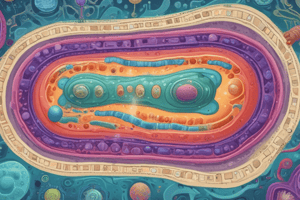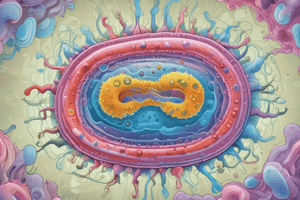Podcast
Questions and Answers
True or false: Prokaryotes have a nucleus or membrane-enclosed organelles.
True or false: Prokaryotes have a nucleus or membrane-enclosed organelles.
True (A)
True or false: Prokaryotes have a short doubling time due to rapid reproduction.
True or false: Prokaryotes have a short doubling time due to rapid reproduction.
True (A)
True or false: Prokaryotes have fimbriae for adhesion and pili for conjugation.
True or false: Prokaryotes have fimbriae for adhesion and pili for conjugation.
True (A)
True or false: Prokaryotes have flagella for motility.
True or false: Prokaryotes have flagella for motility.
True or false: Prokaryotes have a capsule for adhesion and evasion.
True or false: Prokaryotes have a capsule for adhesion and evasion.
True or false: Prokaryotes have an internal organization.
True or false: Prokaryotes have an internal organization.
True or false: Prokaryotes have a cell wall.
True or false: Prokaryotes have a cell wall.
True or false: Prokaryotes have a circular chromosome with plasmids.
True or false: Prokaryotes have a circular chromosome with plasmids.
True or false: Prokaryotes can undergo genetic recombination.
True or false: Prokaryotes can undergo genetic recombination.
True or false: Prokaryotes can be mutualists, commensals, or pathogens.
True or false: Prokaryotes can be mutualists, commensals, or pathogens.
True or false: Prokaryotes have a circular chromosome with plasmids.
True or false: Prokaryotes have a circular chromosome with plasmids.
True or false: Prokaryotes have fimbriae for adhesion and pili for conjugation.
True or false: Prokaryotes have fimbriae for adhesion and pili for conjugation.
True or false: Prokaryotes have a capsule for adhesion and evasion.
True or false: Prokaryotes have a capsule for adhesion and evasion.
True or false: Prokaryotes have flagella for motility.
True or false: Prokaryotes have flagella for motility.
True or false: Prokaryotes have a cell wall.
True or false: Prokaryotes have a cell wall.
Which of the following is NOT a structural adaptation of prokaryotes?
Which of the following is NOT a structural adaptation of prokaryotes?
What is the function of fimbriae in prokaryotes?
What is the function of fimbriae in prokaryotes?
Which of the following is NOT a characteristic of prokaryotic chromosomes?
Which of the following is NOT a characteristic of prokaryotic chromosomes?
What is the main advantage of prokaryotes' short doubling time?
What is the main advantage of prokaryotes' short doubling time?
What is the function of the capsule in prokaryotes?
What is the function of the capsule in prokaryotes?
What is the role of pili in prokaryotes?
What is the role of pili in prokaryotes?
What is the main difference between prokaryotes and eukaryotes in terms of internal organization?
What is the main difference between prokaryotes and eukaryotes in terms of internal organization?
What is the primary purpose of flagella in prokaryotes?
What is the primary purpose of flagella in prokaryotes?
Which of the following is NOT a metabolic adaptation of prokaryotes?
Which of the following is NOT a metabolic adaptation of prokaryotes?
What is the process by which prokaryotes reproduce?
What is the process by which prokaryotes reproduce?
Flashcards are hidden until you start studying




